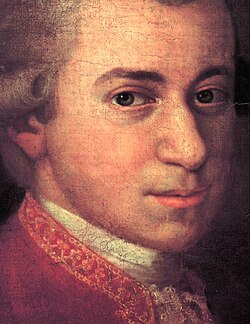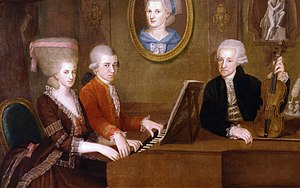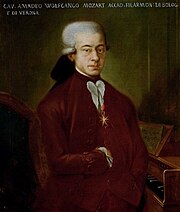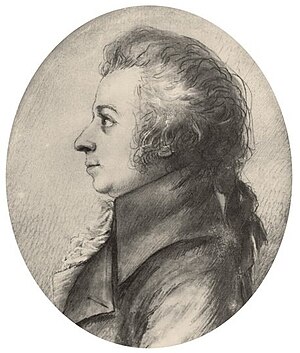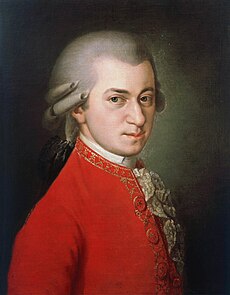Wednesday, December 12, 2007
Wolfgang Amadeus Mozart (IPA: [ˈvɔlfgaŋ amaˈdeus ˈmoːtsart], baptized Joannes Chrysostomus Wolfgangus Theophilus Mozart) (27 January 1756 – 5 December 1791) was a prolific and influential composer of the Classical era. His output of over 600 compositions includes works widely acknowledged as pinnacles of symphonic, concertante, chamber, piano, operatic, and choral music. Mozart is among the most enduringly popular of classical composers and many of his works are part of the standard concert repertoire.
Contents[hide] |
Biography
Family and early years
Wolfgang Amadeus Mozart was born to Leopold and Anna Maria Pertl Mozart in Getreidegasse 9 in Salzburg, the capital of the sovereign Archbishopric of Salzburg, in what is now Austria, then part of the Holy Roman Empire. His only sibling who survived past birth was his sister Maria Anna (1751-1829), called "Nannerl". Wolfgang was baptized the day after his birth at St. Rupert's Cathedral. The baptismal record gives his name in Latinized form as Joannes Chrysostomus Wolfgangus Theophilus Mozart. Mozart generally called himself "Wolfgang Amadé Mozart"[1]as an adult, but there were many variants (see Mozart's name).
Mozart's father Leopold Mozart (1719–1787) was deputy Kapellmeister to the court orchestra of the Archbishop of Salzburg and a minor composer.[2] He was also an experienced teacher; in the year of Mozart's birth he published a successful violin textbook, Versuch einer gründlichen Violinschule.[3]
When Nannerl was seven, Leopold began giving her keyboard lessons. The three-year old Mozart looked on, evidently with fascination: his sister later recorded that at this age "he often spent much time at the clavier [keyboard], picking out thirds, ... and his pleasure showed it sounded good [to him]."[4] Nannerl continued: "in the fourth year of his age his father, for a game as it were, began to teach him a few minuets and pieces at the clavier. ... he could play it faultlessly and with the greatest delicacy, and keeping exactly in time. ... At the age of five he was already composing little pieces, which he played to his father who wrote them down."[5] Among them were the Andante (K. 1a) and Allegro in C (K. 1b).[6]
Biographer Maynard Solomon[7] notes that while Leopold was a very devoted teacher to his children, there is evidence that Wolfgang was motivated to make progress even beyond what his father was teaching him. His first independent (and ink-spattered) composition, and his initial ability to play the violin, were both his own doing and were a great surprise to Leopold. The father and son seem to have been close; both of the precocious episodes just mentioned brought tears to Leopold's eyes.[8]
Leopold eventually gave up composing when his son's outstanding musical talents became evident.[9] He was Wolfgang's only teacher in his earliest years. He taught his children languages and academic subjects as well as music.[10]
1762–1773: Years of travel
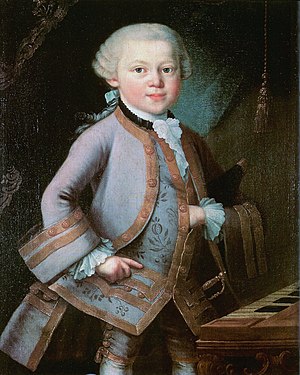
During Mozart's formative years, his family made several European journeys in which the children were exhibited as child prodigies. These began with an exhibition in 1762 at the Court of the Elector of Bavaria in Munich, then in the same year at the Imperial Court in Vienna and Prague. A long concert tour spanning three and a half years followed, taking the family to the courts of Munich, Mannheim, Paris, London,[11] The Hague, again to Paris, and back home via Zürich, Donaueschingen, and Munich. During this trip Mozart met a great number of musicians and acquainted himself with the works of other composers. A particularly important influence was Johann Christian Bach, who met Mozart in London in 1764–65. The family again went to Vienna in late 1767 and remained there until December 1768. On this trip Mozart contracted smallpox, but his father refused to have him inoculated, believing that it was "God's will" whether the boy live or die.[12]
After one year in Salzburg, three trips to Italy followed, this time with just Leopold, leaving Wolfgang's mother and sister at home. These took place from December 1769 to March 1771, from August to December 1771, and from October 1772 to March 1773. The first trip resembled the earlier journeys, with the purpose of displaying the now-teenaged Mozart's abilities as a performer and as a rapidly maturing composer. Mozart met G.B. Martini in Bologna, and was accepted as a member of the famous Accademia Filarmonica. In Rome he heard Gregorio Allegri's Miserere once in performance in the Sistine Chapel then wrote it out in its entirety from memory, only returning to correct minor errors; thus producing the first illegal copy of this closely-guarded property of the Vatican.
In Milan Mozart wrote an opera Mitridate Rè di Ponto (1770), performed with success. This led to further opera commissions, and Wolfgang and Leopold returned twice from Salzburg to Milan for the composition and premieres of Ascanio in Alba (1771) and Lucio Silla (1772).
Toward the end of the final Italian journey Mozart wrote the first of his works that is still widely performed today, the solo cantata "Exsultate, jubilate", K. 165.
1773–1777: The Salzburg court
Following his final return with his father from Italy (13 March 1773), Mozart was employed as a court musician by the ruler of Salzburg Prince-Archbishop Hieronymus Colloredo. Mozart was a "favorite son" in Salzburg, where he had a great number of friends and admirers,[13] and he had the opportunity to compose in many genres, including symphonies, sonatas, string quartets, serenades, and the occasional opera. Some of the works he produced during this early period are widely performed today. For instance, during the period between April and December of 1775, Mozart developed an enthusiasm for violin concertos, producing a series of five (the only ones he ever wrote), steadily increasing in their musical sophistication. The last three (K. 216, K. 218, K. 219) are now staples of the repertoire. In 1776 he produced a series of piano concertos, culminating in the E flat concerto K. 271 of early 1777, considered by critics to be a breakthrough work.[14]
Despite these artistic successes, Mozart gradually grew more discontented with Salzburg and made increasingly strenuous efforts to find a position elsewhere. The reason seems to be in part his low salary, 150 florins per year.[15] In addition, Mozart longed to compose operas, and Salzburg provided at best rare occasions for opera productions. The situation became worse in 1775 when the court theater was closed, and the other theater in Salzburg was largely reserved for visiting troupes.[16]
Two long job-hunting expeditions interrupted this long Salzburg stay: Wolfgang and Leopold (they were both looking) visited Vienna from 14 July to 26 September 1773 and Munich from 6 December 1774 to March 1775. Neither visit was successful, though the Munich journey resulted in a popular success with the premiere of Mozart's opera La finta giardiniera[17]
1777–1778: Paris journey
On 23 September 1777, Mozart began yet another job-hunting tour, this time accompanied by his mother Anna Maria. The visit included Munich, Mannheim, and Paris.[18] In Mannheim he became acquainted with members of the Mannheim orchestra, the best in Europe at the time. He also fell in love with Aloysia Weber, one of four daughters in a musical family. Mozart moved on to Paris and attempted to build his career there, but was unsuccessful (he did obtain a job offer as organist at Versailles, but it was a job he did not want[19]). The visit to Paris was an especially unhappy one because Mozart's mother took ill and died there, 23 June 1778.[20] On his way back to Salzburg Mozart passed through Munich again, where Aloysia, now employed at the opera there as a singer, indicated she was no longer interested in him.[21]
Mozart's discontent with Salzburg continued after his return.
The question arises why Mozart, despite his talent, was unable to find a job on this trip. Maynard Solomon has suggested that the problem lay in conflict with father Leopold, who insisted that Mozart find a high-level position that would support the entire family. Wolfgang favored the alternative strategy of settling in a major city, working as a freelance, and cultivating the aristocracy to the point that he would be favored for an important job; this had worked earlier for other musicians such as Haydn. The plan Leopold imposed, coupled with Mozart's youth (he was only 21 when he left Salzburg), seems to have had foreordained failure.[22]
1781: Departure to Vienna
In January 1781, Mozart's opera Idomeneo, premiered with "considerable success" (New Grove) in Munich. The following March, the composer was summoned to Vienna, where his employer, Prince-Archbishop Colloredo of Salzburg, was attending the celebrations for the installation of the Emperor Joseph II. Mozart, who had just experienced success in Munich, was offended when Colloredo treated him as a mere servant, and particularly when the Archbishop forbade him to perform before the Emperor at Countess Thun's (for a fee that would have been fully half of his Salzburg salary).[23] In May the resulting quarrel intensified: Mozart attempted to resign, and was refused. The following month, however, the delayed permission was granted, but a grossly insulting way: Mozart was dismissed literally "with a kick in the arse", administered by the Archbishop's steward, Count Arco.[24] In the meantime, Mozart had been noticing opportunities to earn a good living in Vienna, and he felt he ought to settle there and develop his own freelance career.[25]
The quarrel with the Archbishop was made harder for Mozart by the fact that his father took the Archbishop's side: hoping fervently that his son would come home when Colloredo returned, his father exchanged emotionally intense letters with Wolfgang, urging him to reconcile with their employer. Wolfgang passionately defended his intention to pursue his career alone in Vienna. The debate ended when Mozart was dismissed, freeing himself both of his oppressive employer and of his father's demands to return. Solomon thus characterizes Mozart's resignation as a "revolutionary step," and it greatly altered the course of his future life.[26]
Early Vienna years
Mozart's new career in Vienna began very well. He performed often as a pianist, notably in a competition before the Emperor with Muzio Clementi, 24 December 1781,[27] and according to the New Grove, he soon "had established himself as the finest keyboard player in Vienna."[28] Mozart also prospered as a composer: during 1781–1782 he wrote the opera Die Entführung aus dem Serail ("The Abduction from the Seraglio"), which premiered 16 July 1782 and achieved a huge success. The work was soon being performed "throughout German-speaking Europe",[29] and fully established Mozart's reputation as a composer.
Near the height of his quarrels with Archbishop Colloredo, Mozart moved in (1 May or 2 May 1781) with the Weber family, who had moved to Vienna from Mannheim. The father, Fridolin, had died, and the Webers were now taking in lodgers to make ends meet.[30] Aloysia, who had earlier rejected Mozart's suit, was now married to the actor Joseph Lange, and Mozart's interest shifted to the third daughter, Constanze. The couple were married, with father Leopold's "grudging consent" (New Grove), on August 4, 1782.[31] They had six children, of whom only two survived infancy: Karl Thomas (1784–1858) and Franz Xaver Wolfgang (1791–1844; later a minor composer himself).
During 1782–1783, Mozart became closely acquainted with the work of J. S. Bach and G.F. Handel as a result of the influence of Baron Gottfried van Swieten, who owned many manuscripts of works by the Baroque masters. Mozart's study of these works led first to a number of works imitating Baroque style and later had a powerful influence on his own personal musical language, for example the fugal passages in Die Zauberflöte ("The Magic Flute"), and in the finale of Symphony No. 41.
In 1783, Wolfgang and Constanze visited Wolfgang's family in Salzburg, but the visit was not a success, as Leopold and Nannerl were, at best, only polite to Constanze. However, the visit sparked the composition of one of Mozart's great liturgical pieces, the Mass in C Minor, which, though not completed, was premiered in Salzburg. Constanze sang in the premiere.[32]
At some (unknown) time following his move to Vienna, Mozart met Joseph Haydn and the two composers became friends; see Haydn and Mozart. When Haydn visited Vienna, they sometimes played together in an impromptu string quartet. Mozart's six quartets dedicated to Haydn (K. 387, K. 421, K. 428, K. 458, K. 464, and K. 465) date from 1782–85, and are often judged to be his response to Haydn's Opus 33 set from 1781. Haydn stood in awe of Mozart; when he first heard the last three of Mozart's series, he told the visiting Leopold, "Before God and as an honest man I tell you that your son is the greatest composer known to me either in person or by name: He has taste, and, furthermore, the most profound knowledge of composition."[33]
During the years 1782–1785, Mozart put on a series of concerts in which he appeared as soloist in his own piano concertos. He wrote three or four concertos for each concert season, and since space in the theaters was scarce, he booked unconventional venues: a large room in the Trattnerhof, an apartment building; and the ballroom of the Mehlgrube, a restaurant.[34] The concerts were very popular, and the concertos Mozart composed for them are considered among his finest works. Solomon writes that during this period Mozart created "a harmonious connection between an eager composer-performer and a delighted audience, which was given the opportunity of witnessing the transformation and perfection of a major musical genre".[35]
With the substantial money Mozart earned in his concerts and elsewhere, he and Constanze adopted a rather plush lifestyle. They moved to an expensive apartment, with a rent of 460 florins.[36] Mozart also bought a fine fortepiano from Anton Walter for about 900 florins, and a billiards table for about 300.[37] The Mozarts also sent their son Karl Thomas to an expensive boarding school[38] and kept servants. These choices inhibited saving, and were the partial cause of a stressful financial situation for the Mozart family a few years later.[39]
On 14 December 1784, Mozart became a Mason, admitted to the lodge "Zur Wohltätigkeit" ("Beneficence").[40] Freemasonry played an important role in the remainder of Mozart's life; he attended many meetings, a number of his friends were Masons, and on various occasions he composed Masonic music. For details see Mozart and Freemasonry.
1786–1787: Return to opera
Despite the great success of Die Entführung aus dem Serail, Mozart did little writing of operas during the years that followed it, producing only two unfinished works and the one-act Der Schauspieldirektor. He focused instead on his career as a piano soloist and writer of concertos. However, around the end of 1785, Mozart reshifted his focus again. He ceased to write piano concertos on a regular basis,[41] and began his famous operatic collaboration with the librettist Lorenzo da Ponte. 1786 saw the Vienna premiere of The Marriage of Figaro, which was quite successful in Vienna and even more so in a Prague production later the same year. The Prague success led to a commission for a second Mozart-Da Ponte opera, Don Giovanni, which premiered 1787 to acclaim in Prague and was also produced, with some success, in Vienna in 1788. Both operas are considered among Mozart's most important works and are mainstays of the operatic repertoire today; their musical complexity caused difficulty for both listeners and performers alike at their premieres.
In December 1787 Mozart finally obtained a steady post under aristocratic patronage. Emperor Joseph II appointed him as his "chamber composer", a post vacated the previous month when Gluck died. It was not a full-time job, however. It paid only 800 florins per year, and merely required Mozart to compose dances for the annual balls in the Redoutensaal. Mozart complained to Constanze that the pay was "too much for what I do, too little for what I could do".[42] However, even this much proved important to Mozart later on when hard times arrived. Court records show that Joseph's intent was explicitly to help make sure that Mozart, whom he esteemed, did not leave Vienna to seek better prospects elsewhere.[43]
In 1787, the young Ludwig van Beethoven traveled to Vienna for two weeks in hopes of studying with Mozart. The evidence for what happened during this visit is conflicting, and at least three hypotheses are in play: that Mozart heard Beethoven play and praised him, that Mozart rejected Beethoven as a student, and that they never even met. For discussion, see Mozart and Beethoven.
1788–1790
Toward the end of the decade, Mozart's career declined.
Around 1786 he had ceased to appear frequently in public concerts, and his income dropped.[44] This was in general a difficult time for musicians in Vienna, since between 1788 and 1791 Austria was at war (see Austro-Turkish War (1788–1791)), and both the general level of prosperity and the ability of the aristocracy to support music had declined.[45]
By mid-1788, Mozart and his family moved from central Vienna to cheaper lodgings in the suburb of Alsergrund.[46] Mozart began to borrow money, most often from his friend and fellow Mason Michael Puchberg; "a dismal series of begging letters" (New Grove) survives. Maynard Solomon and others have suggested that Mozart suffered from depression at this time, and it seems his output rate sank somewhat (see Köchel-Verzeichnis). The major works of the period include the last three symphonies (1788: 39, 40, 41; it is not certain whether these were performed in Mozart's lifetime), and the last of the three Da Ponte operas, Cosi fan tutte, premiered 1790.
During this time Mozart made long journeys hoping to improve his fortunes: a visit in spring of 1789 to Leipzig, Dresden, and Berlin (see Mozart's Berlin journey), and a 1790 visit to Frankfurt, Mannheim, and other German cities. The trips produced only isolated success and did not solve Mozart's financial problems.
1791
Mozart's last year was, until his final illness struck, one of great productivity and (in the view of Maynard Solomon) personal recovery.[47] During this time Mozart wrote a great deal of music, including some of his most admired works: the opera The Magic Flute, the final piano concerto (K. 595 in B flat), the Clarinet Concerto K. 622, the last in his great series of string quintets (K. 614 in E flat), the motet Ave verum corpus K. 618, and the unfinished Requiem K. 626.
Mozart's financial situation, which in 1790 was the source of extreme anxiety to him, also began to improve. Although the evidence is uncertain[48] it appears that admiring wealthy patrons in Hungary and in Amsterdam pledged annuities to Mozart, in return for the occasional composition. Mozart also probably made considerable money from the sale of dance music that he wrote for his job as Imperial chamber composer.[49] He ceased to borrow large sums from Puchberg and made a start on paying off his debts.[50]
Lastly, Mozart experienced great satisfaction in the public success of some his works, notably The Magic Flute (performed many times even during the short period between its premiere and Mozart's death)[51] and the Little Masonic Cantata K. 623, premiered 15 November 1791.[52]
Final illness and death
Mozart fell ill while in Prague, for the 6 September premiere of his opera La clemenza di Tito, written in 1791 on commission for the coronation festivities of the Emperor.[53] He was able to continue his professional functions for some time, for instance conducting the premiere of The Magic Flute on September 30. The illness intensified on 20 November, at which point Mozart became bedridden, suffering from swelling, pain, and vomiting.
Mozart was tended in his final illness by Constanze, her youngest sister Sophie, and the family doctor, Thomas Franz Closset. There is evidence that he was mentally occupied with the task of finishing his Requiem (see Death of Mozart). However, the evidence that he actually dictated passages to Süssmayr is very slim.[54]
Mozart died at 1 in the morning on December 5. The New Grove describes his funeral thus: "Mozart was buried in a common grave, in accordance with contemporary Viennese custom, at the St Marx cemetery outside the city on 7 December. If, as later reports say, no mourners attended, that too is consistent with Viennese burial customs at the time; later Jahn (1856)[55] wrote that Salieri, Süssmayr, van Swieten and two other musicians were present. The tale of a storm and snow is false; the day was calm and mild."[56]
The cause of Mozart's death cannot be determined with certainty. His death record listed "hitziges Frieselfieber" ("severe miliary fever", referring to a rash that looks like millet seeds), a description that does not suffice to identify the cause as it would be diagnosed in modern medicine. Dozens of theories have been proposed, including trichinosis, influenza, mercury poisoning, and a rare kidney ailment. The practice of bleeding medical patients, common at that time, is also cited as a contributing cause. However, the most widely accepted version is that he died of acute rheumatic fever; he had had three or even four known attacks of it since his childhood, and this particular disease has a tendency to recur, leaving increasingly serious consequences each time, such as rampant infection and heart valve damage.[57]
Mozart's spare funeral did not reflect his standing with the public as a composer: memorial services and concerts in Vienna and Prague were well attended.[58] Indeed, during the period following his death, Mozart's musical reputation rose substantially; Solomon describes an "unprecedented wave of enthusiasm"[59] for his work. Biographies were written (initially by Schlichtegroll, Niemetschek, and Nissen), and publishers vied to produce complete editions of his works.[60]
Portrait
Mozart's physical appearance was described by tenor Michael Kelly, in his Reminiscences: "a remarkable small man, very thin and pale, with a profusion of fine, fair hair of which he was rather vain". His early biographer Niemetschek wrote, "there was nothing special about [his] physique ... He was small and his countenance, except for his large intense eyes, gave no signs of his genius." His facial complexion was pitted, a reminder of his childhood case of smallpox. He loved elegant clothing: Kelly remembered him at a rehearsal: he "was on the stage with his crimson pelisse and gold-laced cocked hat, giving the time of the music to the orchestra". Of his voice Constanze later wrote that it "was a tenor, rather soft in speaking and delicate in singing, but when anything excited him, or it became necessary to exert it, it was both powerful and energetic."[61]
Mozart worked very hard, a great deal of the time, and finished works where necessary at a tremendous pace. When composing he often made sketches and drafts, though (unlike Beethoven's sketches) these are mostly not preserved, Constanze having destroyed them after his death.[62]
Mozart also enjoyed billiards and liked dancing. He kept pets (a canary, a starling and a dog), and kept a horse for recreational riding.[63]
He was raised Roman Catholic and remained a loyal member of the Catholic Church throughout his life;[64] see Mozart and Roman Catholicism.
Mozart lived at the center of Viennese musical life, and knew a great number of people, including not just his fellow musicians, but also theatrical performers, fellow transplanted Salzburgers, and many aristocrats, including a fairly close acquaintance with the Emperor, Joseph II. Mozart had a considerable number of friends, of whom Solomon estimates the three closest were Gottfried Janequin, Count August Hatzfeld, and Sigmund Barisani. Others included the singers Franz Xaver Gerl and Benedikt Schack, Haydn (mentioned above), and the horn player Joseph Leutgeb. Leutgeb and Mozart carried on a curious kind of friendly mockery, often with Leutgeb as the butt of Mozart's practical jokes.[65]
Particularly in his youth, Mozart had a striking fondness for scatological and sexual humor, which is preserved in his many surviving letters, notably those written to his cousin Maria Anna Thekla Mozart around 1777–1778, but also in his correspondence with his sister Nannerl.[66] Mozart even wrote scatological music, the canon "Leck mich im Arsch" (literally "Lick me in the arse", sometimes idiomatically translated "Kiss my arse" or "Get stuffed") K. 231.
Works, musical style, and innovations
Style
Mozart's music, like Haydn's, stands as an archetypal example of the Classical style. His works spanned the period during which that style transformed from one exemplified by the style galant to one that began to incorporate some of the contrapuntal complexities of the late Baroque, complexities against which the galant style had been a reaction. Mozart's own stylistic development closely paralleled the development of the classical style as a whole. In addition, he was a versatile composer and wrote in almost every major genre, including symphony, opera, the solo concerto, chamber music including string quartet and string quintet, and the piano sonata. While none of these genres were new, the piano concerto was almost single-handedly developed and popularized by Mozart. He also wrote a great deal of religious music, including masses; and he composed many dances, divertimenti, serenades, and other forms of light entertainment.
The central traits of the classical style can all be identified in Mozart's music. Clarity, balance, and transparency are hallmarks of his work. A more simplistic notion of the delicacy of his music obscures the exceptional power of some of his finest masterpieces, such as the Piano Concerto No. 24 in C minor, K. 491, the Symphony No. 40 in G minor, K. 550, and the opera Don Giovanni. Charles Rosen has written (1997): "It is only through recognizing the violence and sensuality at the center of Mozart's work that we can make a start towards a comprehension of his structures and an insight into his magnificence. In a paradoxical way, Schumann's superficial characterization of the G minor Symphony can help us to see Mozart's daemon more steadily. In all of Mozart's supreme expressions of suffering and terror, there is something shockingly voluptuous." Especially during his last decade, Mozart explored chromatic harmony to a degree rare at the time. The slow introduction to the "Dissonant" Quartet, K. 465 rapidly explodes a shallow understanding of Mozart's style as light and pleasant.
From an early age, Mozart had a gift for imitating the music he heard. His travels provided him with a rare collection of experiences from which to create his unique compositional language. In London as a child, he met J.C. Bach and heard his music. In Paris, Mannheim, and Vienna, he heard the work of composers active there, as well as the Mannheim orchestra. In Italy, he encountered the Italian overture and opera buffa, both of which were to be hugely influential on his development. Both in London and Italy, the galant style was all the rage: simple, light music, with a mania for cadencing, an emphasis on tonic, dominant, and subdominant to the exclusion of other chords, symmetrical phrases, and clearly articulated structures.[67] This style, out of which the classical style evolved, was a reaction against the complexity of late Baroque music. Some of Mozart's early symphonies are Italian overtures, with three movements running into each other; many are "homotonal" (each movement in the same key, with the slow movement in the parallel minor). Others mimic the works of J.C. Bach, and others show the simple rounded binary forms commonly being written by composers in Vienna. One of the most recognizable features of Mozart's works is a sequence of harmonies or modes that usually leads to a cadence in the dominant or tonic key. This sequence is essentially borrowed from Baroque music's Phrygian style, especially J. S. Bach. But Mozart shifted the sequence so that the cadence ended on the stronger half, i.e., the first beat of the bar.
As Mozart matured, he began to incorporate some more features of Baroque styles into his music. For example, the Symphony No. 29 in A Major K. 201 uses a contrapuntal main theme in its first movement, and experimentation with irregular phrase lengths. Some of his quartets from 1773 have fugal finales, probably influenced by Haydn, who included three such finales in his recently published Opus 20 set. The influence of the Sturm und Drang ("Storm and Stress") period in music, with its brief foreshadowing of the Romantic era to come, is evident in some of the music of both composers at that time. Mozart's Symphony No. 25 in G minor, K. 183 is another excellent example of this style.
Over the course of his working life, Mozart switched his focus from instrumental music to operas, and back again. He wrote operas in each of the styles current in Europe: opera buffa, such as The Marriage of Figaro, Don Giovanni, or Così fan tutte; opera seria, such as Idomeneo; and Singspiel, of which Die Zauberflöte is probably the most famous example by any composer. In his later operas, he developed the use of subtle changes in instrumentation, orchestration, and tone colour to express or highlight psychological or emotional states and dramatic shifts. Here his advances in opera and instrumental composing interacted. His increasingly sophisticated use of the orchestra in the symphonies and concerti served as a resource in his operatic orchestration, and his developing subtlety in using the orchestra to psychological effect in his operas was reflected in his later non-operatic compositions.[68]
Influence
Mozart's most famous pupil was probably Johann Nepomuk Hummel, a transitional figure between Classical and Romantic eras whom the Mozarts took into their Vienna home for two years as a child during his studies.[69]
More important is the influence Mozart had on later composers through the example of his works. With the surge in his reputation following his death, the study of Mozart's works became part of the training of every classical musician.[citation needed]
Ludwig van Beethoven, whose life overlapped with Mozart's, seems to have been particularly strongly influenced by him. Beethoven became closely acquainted with Mozart's work as a teenager (he is thought to have played Mozart's operas in the court orchestra in Bonn).[70] He traveled to Vienna in 1787 in the hope (unfulfilled) of studying with Mozart (see Mozart and Beethoven). It is thought that some of Beethoven's works have direct models in comparable works by Mozart; for a listing of examples see Mozart and Beethoven. Beethoven also wrote cadenzas (WoO 58) to Mozart's D minor piano concerto K. 466.
A number of composers have paid homage to Mozart by writing sets of variations on his themes. Beethoven wrote four such sets ((Op. 66, WoO 28, WoO 40, WoO 46; see List of compositions by Ludwig van Beethoven). Others include Frédéric Chopin's variations for solo piano on "Là ci darem la mano" from Don Giovanni (1827) and Max Reger's Variations and Fugue on a Theme by Mozart (1914), based on the variation theme in the piano sonata K. 331.[71] Pyotr Ilyich Tchaikovsky wrote his Orchestral Suite No. 4 in G "Mozartiana" (1887) in tribute to Mozart.
Mozart's work has been widely adapted for popular music; for instances see List of popular songs based on classical music.
Köchel catalogue
For purposes of careful identification of any work by Mozart, the Köchel catalogue number is used. This is a unique number assigned (on a chronological basis) to every known work by Mozart. The first edition of the Köchel catalogue was completed in 1862 by Ludwig von Köchel. It has repeatedly been updated since then, as scholarly research improves our knowledge of the dates and authenticity of individual works.
Mozart in fiction
Authors of fictional works have found Mozart's life a compelling source of raw material. An especially popular case is the supposed rivalry between Mozart and Antonio Salieri, particularly the idea that it was poison received from the latter that caused Mozart's death; this is the subject of Aleksandr Pushkin's play Mozart and Salieri and Nicolai Rimsky-Korsakov's opera Mozart and Salieri. The idea receives no support at all from modern scholars.[72]
Modern audiences have been gripped by the account of Mozart's life given in Peter Shaffer's play Amadeus, as well as the film based on the play. Shaffer seems to have been especially taken by the contrast between Mozart's enjoyment of vulgarity (noted above) and the sublime character of his music. The scene in Shaffer's work in which Mozart dictates music to Salieri on his deathbed is entirely an author's fancy; for the question of whether Mozart did any dictation on his deathbed at all see Death of Mozart.
Media
Orchestral
| K191 | |
| | |
| Bassoon Concerto in B-flat major, 1st movement, Allegro | |
| K191 | |
| | |
| Bassoon Concerto in B-flat major, 2nd movement, Andante ma adagio | |
| K191 | |
| | |
| Bassoon Concerto in B-flat major, 3rd movement | |
| K550 | |
| | |
| Mozart's 40th Symphony, 1st movement | |
| K550 | |
| | |
| Mozart's 40th Symphony, 2nd movement | |
| K550 | |
| | |
| Mozart's 40th Symphony, 3rd movement | |
| K550 | |
| | |
| Mozart's 40th Symphony, 4th movement | |
| K527 | |
| | |
| Overture to Don Giovanni | |
| K525 | |
| | |
| Eine kleine Nachtmusik, 4th movement | |
| K364, 1st movement | |
| | |
| Sinfonia Concertante for Violin, Viola and Orchestra | |
| K364, 2nd movement | |
| | |
| Sinfonia Concertante for Violin, Viola and Orchestra | |
| K364, 3rd movement | |
| | |
| Sinfonia Concertante for Violin, Viola and Orchestra | |
| K314 | |
| | |
| Concerto in D for Flute | |
| K622 | |
| | |
| Clarinet Concerto in A major, 1st movement | |
| K622 | |
| | |
| Clarinet Concerto in A major, 2nd movement | |
| K622 | |
| | |
| Clarinet Concerto in A major, 3rd movement | |
| K466 | |
| | |
| Piano Concerto No.20 in D minor, 1st movement | |
Vocal
| K321, 1st movement | |
| | |
| Vesperae de dominica - dixit dominus | |
| K321, 2nd movement | |
| | |
| Vesperae de dominica - confitebor | |
| K321, 3rd movement | |
| | |
| Vesperae de dominica - beatus vir | |
| K321, 4th movement | |
| | |
| Vesperae de dominica - laudate pueri | |
| K321, 5th movement | |
| | |
| Vesperae de dominica - laudate dominum | |
| K321, 6th movement | |
| | |
| Vesperae de dominica - magnificat | |
Piano
| Rondo Alla Turca from K331 | |
| | |
| Piano Sonata No. 11 in A major, 3rd movement | |
| K545 | |
| | |
| Piano Sonata in C major, 1st movement | |
| K545 | |
| | |
| Piano Sonata in C major, 2nd movement | |
| K545 | |
| | |
| Piano Sonata in C major, 3rd movement | |
| Piano Sonata No. 8 in A minor, K310 - Allegro maestoso | |
| | |
| performed by Randolph Hokanson | |
| Piano Sonata No. 8 in A minor -Andante cantabile con espressione | |
| | |
| performed by Randolph Hokanson | |
| Piano Sonata No. 8 in A minor- Presto | |
| | |
| performed by Randolph Hokanson | |
| K378/K317d | |
| | |
| Piano/Violin Sonata in B Flat (arranged for flute) | |
-
- Problems playing the files? See media help.
Subscribe to Comments [Atom]
